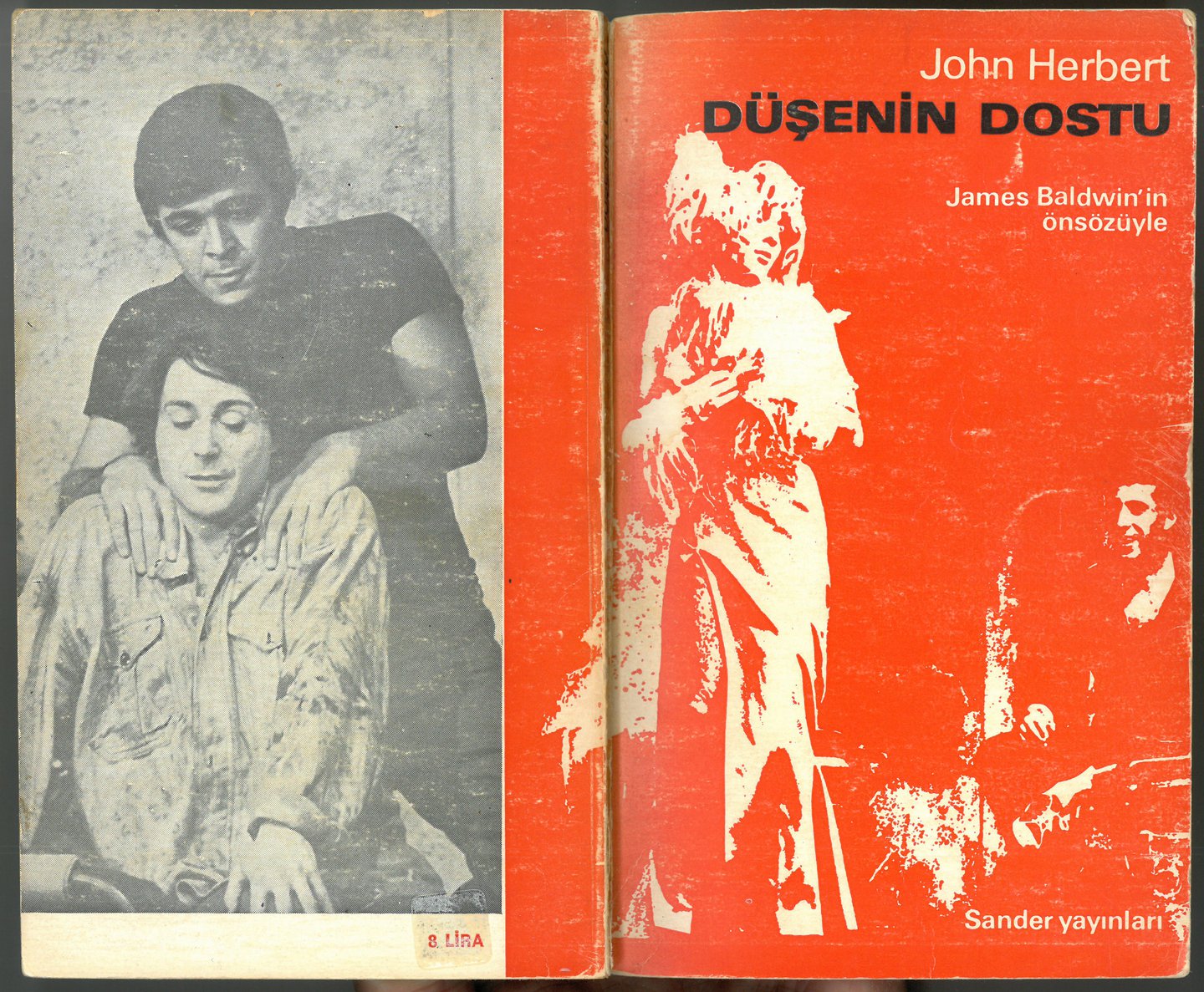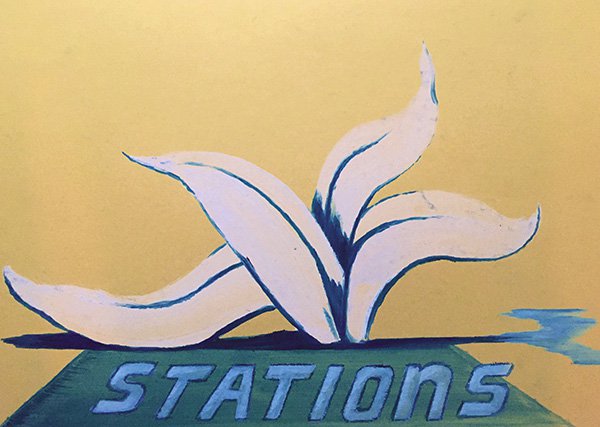– Leseperformance [TR, DE, EN] & Musik –
Doppelte Gefangenschaft
Nur ein einziges Foto belegt, dass James Baldwin in seiner Istanbuler Dekade (etwa 1961 – 1971) dem berühmten Sänger und Schauspieler Zeki Müren begegnete. Es ist ein Gruppenfoto von 1969 im Foyer des Gülriz Sururi-Engin Cezzar Theater in Istanbul. Kein leicht anzusehendes Foto. Der Bildausschnitt drängt James Baldwin an den Rand des Fotos und schneidet ihn zur Hälfte an. Zeki Müren hingegen posiert in der Mitte des Bildes. Einerseits könnten die beiden Männer nicht unterschiedlicher sein. Der eine flieht aus den USA, während der andere eben dieses Land und besonders dessen Unterhaltungskultur idealisiert. Andrerseits – wenn auch mit unterschiedlicher Intensität – beschäftigen sich beide mit zwei Formen der Gefangenschaft: In der Gesellschaft und in der Gefängniszelle. Hier treffen sie sich.
Am 23.12.1969 adaptiert Baldwin das Stück Fortune and Men’s Eyes des kanadischen Dramaturgen John Herbert für das Gülriz Sururi-Engin Cezzar Theater in Istanbul. Die gesamte Handlung spielt sich in einer Gefängniszelle ab. In dem Stück bündeln sich mehrere sozio-politische Anliegen von Baldwin. Zum einen die Kritik am rassistischen Justizsystem der USA, welches die Aktivist:innen der Bürgerrechtsbewegung wie auch insgesamt die Schwarze Bevölkerung kriminalisiert und inhaftiert. Zum anderen seine grundsätzliche Kritik an den gewaltsamen Strukturen des Patriarchats. Selbst die Beschädigten dieser Strukturen – so Fortune and Men’s Eyes – setzten diese fort. Hieran schließt sich Baldwins Diskurs um Homosexualität und homosoziale Intimität an.
Müren wiederum war immer wieder die Idealbesetzung für den in der Gesellschaft gefangenen Charakter. Seine einzige Theaterrolle seiner künstlerischen Laufbahn lässt ihn 1965 zum effeminierten, siebzehnjährigen Collegejungen Tom Lee in Çay ve Sempati (engl. Org. Tea and Sympathy) werden. In Tom Lee erkennt sich Zeki Müren wieder. „Als hätte Robert Anderson dieses Stück auf mich zugeschnitten“, stellt er erstaunt fest. „Ein Jugendlicher, den seine Freunde mit geschmacklosen Scherzen vorführen, weil sie sich nicht in die Tiefen seines Seelenlebens begeben wollen.“ 1953 schrieb Anderson das Melodrama für den Broadway. Als es im Arena Theater in Istanbul aufgeführt wurde, war das Stück bereits von Hollywood verfilmt.
Müren hatte sich von Baldwin erhofft, dass dieser in Istanbul Giovannis Zimmer als ein Theaterstück inszeniert. Mehr noch, dass er die Rolle des Giovannis verkörpern könne. Wie einige der Charaktere in Baldwins Büchern ist auch Giovanni ein Inhaftierter. Einer, der in Paris auf die Vollstreckung seines Todesurteils wartet. Allerdings wird es nie zu einer solchen Theateraufführung kommen.
Über zahlreiche Textpassagen sei es Auszüge aus den Dramen, Essays, Interviews der beiden oder über autofiktionale Elemente schreitet die Leseperfomance Doppelte Gefangenschaft von Gürsoy Doğtaş Formen der homosozialen Intimitäten an den Übergängen zwischen Freiheit und Haft ab.
GÜRSOY DOĞTAŞ ist Kunsthistoriker und arbeitet para-kuratorisch an den Schnittpunkten zu Institutionskritik, struktureller Rassismus und Queerstudies.
///
– okuma performansı (Türkçe, Almanca, İngilizce) & müzik –
Çifte Esaret
Sadece tek bir fotoğraf James Baldwin ve ünlü şarkıcı ve aktör Zeki Müren’in 1961–71 İstanbul yılları arasında tanıştıklarını kanıtlamaktadır. Bu grup fotoğrafı 1969 yılına ait ve İstanbul’da Gülriz Sururi – Engin Cezzar Tiyatrosunun fuayesinde çekilmiş. Fotoğraf net görülmüyor. Fotoğrafın kırpılmış olması James Baldwin’i kenara iterek ortadan ikiye bölünmesine sebep vermiş. Diğer tarafta ise Zeki Müren, fotoğrafın tam ortasında poz vermiş. Bir yandan, bu iki adamın birbirlerinden daha da farklı olamayacağını görüyoruz. Biri ABD’den kaçarken diğeri ise bu ülkeyi ve O’nun eğlence kültürünü idealize ediyor. Öte yandan, farklı yoğunluklarda da olsa her ikisinin de iki tür hapsedilmeyle uğraşmak durumunda kaldığı görülüyor. Toplum ve hapishane hücresi: Buluştukları yer tam da burasıdır.
23 Aralık 1969’da, Baldwin Kanadalı oyun yazarı John Herbert’in Düşenin Dostu (Fortune and Men’s Eyes) adlı eseri uyarlayarak İstanbul’da Gülriz Sururi – Engin Cezzar Tiyatrosu’nda sahneye koydu. Oyundaki tüm sahneler bir hapishane hücresinde geçmekteydi. Baldwin’in sosyo – politik kaygılarından bazıları oyun içinde bağlantılandırılmıştı. Bunlardan biri ABD’deki ırkçı adalet sistemine yönelik eleştirisiydi, ki bu sistem sivil haklar aktivistlerini ve bir bütün olarak siyahi nüfusu suçluyor ve hapsediyor. Bunun ötesinde, oyunda, ataerkilliğin şiddet içeren yapılarına yönelik temel eleştirini de yönlendirmektedir. Düşenin Dostu oyunun vurguladığı temel nokta, bu yapılardan zarar görenlerin bile onları yaşatmaya devam etmesidir. Balwin’in eşcinsellik ve homososyal yakınlık üzerine olan söylemi bu fikir üzerine kuruludur.
Müren ise, oynadığı karakterlerde, toplumun içine hapsolmuş bir karakter olarak defalarca seçilmiş bir oyuncuydu. Sanatsal kariyerindeki tek tiyatro rolünde, 1965 yılında oynanan Çay ve Sempati (Tea and Symphathy) adlı oyunda, Müren’in Tom Lee adında on yedi yaşındaki efemine kolej öğrencisini canlandırdığı görülüyor. Tom Lee karakterinde Zeki Müren kendini görür ve tanır. Zeki Müren sonrasında “sanki Robert Anderson bu oyunu benim için uyarlamış gibi” diye hayretle notunu almış. “Arkadaşlarının, içsel yaşamının derinliklerine inmek istemedikleri için tatsız şakalar yaptıkları bir genç.” 1953 yılında Anderson bu melodramı Broadway için yazar. Oyun İstanbul’da Arena Tiyatrosu’nda oynandığı zaman çoktan Hollywood’da filme çekilmişti.
Müren, Baldwin’in Giovanni’nin Odası adlı oyununun İstanbul’da gerçekleştirileceğini ummuştu. Bunun ötesinde, kendisi Giovanni karakterine hayat vermeyi kafasında kurmuştu. Baldwin’in kitaplarında bazı karakterlerinde olduğu gibi Giovanni de bir mahkumdu. Paris’te ölüm cezasının infazını bekleyen bir mahkum. Ancak bu teatral performans hiçbir zaman gerçekleşmeyecekti.
Çifte Esaret okuma performansında Gürsoy Doğtaş özgürlük ve hapis arasındaki eşikte homososyal yakınlık biçimlerini keşfetmek için oyunlardan alıntılar, denemeler, röportajlar veya otokurgusal unsurlar olsun çok sayıda metin pasajı kullanır.
GÜRSOY DOĞTAŞ kurumsal eleştiri, yapısal ırkçılık ve queer çalışmalarının kesiştiği noktada para-küratöryel olarak çalışan bir sanat tarihçisidir.
///
– reading performance [TR, DE, EN] & music –
Double Imprisonment
Only one photograph proves that James Baldwin met the famous singer and actor Zeki Müren in his Istanbul decade (around 1961 – 1971). It is a group photo from 1969 in the foyer of the Gülriz Sururi-Engin Cezzar Theatre in Istanbul. It is not easy to look at. The cropping pushes James Baldwin to the edge of the photo, cutting him in half. Zeki Müren, on the other hand, poses in the middle of the picture. On the one hand, the two men could not be more different. One is fleeing the USA, while the other idealises this very country and especially its entertainment culture. On the other hand–albeit with different intensity– they both deal with two forms of imprisonment: society and the prison cell. This is where they meet.
On 23 December 1969, Baldwin adapted the play Fortune and Men’s Eyes by the Canadian playwright John Herbert for the Gülriz Sururi-Engin Cezzar Theatre in Istanbul. The entire plot takes place in a prison cell. Several of Baldwin’s socio-political concerns are connected in the play. One is his criticism of the racist justice system in the USA, which criminalises and imprisons activists of the civil rights movement and the black population as a whole. Further, there is his fundamental critique of the violent structures of patriarchy. The point that Fortune and Men’s Eyes makes is that even those damaged by these structures continue to perpetuate them. Baldwin’s discourse on homosexuality and homosocial intimacy builds on this idea.
Müren, in turn, was repeatedly the ideal casting for the character trapped in society. His only theatre role in his artistic career sees him become the effeminate, seventeen-year-old college boy Tom Lee in Çay ve Sempati (English original: Tea and Sympathy) in 1965. In Tom Lee, Zeki Müren recognises himself. “It’s as if Robert Anderson had tailored this play to me,” he notes in amazement. “A teenager whom his friends parade with tasteless jokes because they don’t want to delve into the depths of his inner life.” In 1953, Anderson wrote the melodrama for Broadway. By the time it was performed at the Arena Theatre in Istanbul, the play had already been filmed in Hollywood.
Müren had hoped Baldwin would realise Giovanni’s Room as a play in Istanbul. Even more, that he could embody the role of Giovanni. Like some of the characters in Baldwin’s books, Giovanni is a prisoner. One who is waiting in Paris for the execution of his death sentence. However, this theatrical performance would never take place.
The reading performance Double Imprisonment by Gürsoy Doğtaş uses numerous text passages, whether excerpts from the plays, essays, interviews with the two, or autofictional elements, to explore forms of homosocial intimacies at the threshold between freedom and imprisonment.
GÜRSOY DOĞTAŞ is an art historian working para-curatorially at the intersection of institutional critique, structural racism and queer studies.
Related reading:
James Baldwin in Istanbul: Art and Activism in Exile by Gürsoy Doğtaş
Download text in German/Turkish/English.

